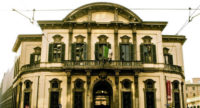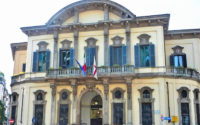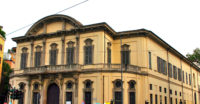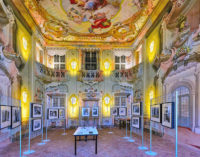Palazzo Sormani, nestled in the heart of Milan, Italy, is a remarkable historical building with an impressive architectural design. Completed in 1779, the Palazzo was initially built as a residence for the noble Sormani family. Over time, it changed hands and served various purposes, including housing government offices and cultural institutions. In 1956, it was repurposed to become the Sormani Library, Milan’s central public library.
The Architecture of Palazzo Sormani
The building’s architectural design is a stunning example of the neoclassical style, characterized by symmetry, simplicity, and elegance. The architect, Francesco Croce, was inspired by the works of Andrea Palladio, a renowned Italian Renaissance architect.
The Exterior
The Palazzo’s majestic façade is a sight to behold. The central entrance is adorned with a beautiful pediment supported by four Ionic columns, creating an inviting and grand atmosphere. The windows are symmetrically arranged, with intricate decorations that showcase the craftsmanship of the era.
The Interior
The interior of Palazzo Sormani is just as breathtaking as its exterior. The magnificent staircase leading to the upper floor is an exquisite example of the neoclassical style, with its elegant balustrade and elaborate stucco decorations. The rooms and halls are adorned with frescoes, chandeliers, and intricate stucco work, providing a glimpse into the opulent lifestyle of the Sormani family.
The Sormani Library
Today, Palazzo Sormani serves as Milan’s central public library, housing an extensive collection of books, periodicals, and other resources. The library is a vital cultural hub for the city, offering various services and programs to cater to the diverse needs of its visitors.
Collections and Resources
The Sormani Library boasts a vast collection of over 600,000 books, including manuscripts, rare books, and periodicals. The library also provides access to digital resources, such as e-books and online databases, ensuring that visitors have access to a wealth of information at their fingertips.
The Reading Rooms
The library features several elegant reading rooms, each with its unique charm and atmosphere, providing a quiet and inspiring space for visitors to read, study, or work.
The Sala Maria Teresa
Named after Empress Maria Theresa of Austria, this stunning room features beautiful frescoes and stuccowork, creating a regal ambiance for visitors to enjoy.
The Sala Borsa
This spacious and elegant room, once the Stock Exchange Hall, is now a serene haven for readers.
The Sala Alessandro Manzoni
Dedicated to the famous Italian writer Alessandro Manzoni, this room is adorned with exquisite wooden bookcases and paintings, providing a cozy and inspiring atmosphere for literary enthusiasts.
Palazzo Sormani frequently hosts a variety of cultural events and exhibitions throughout the year, such as art exhibitions, book presentations, conferences, and workshops. These events aim to promote culture, knowledge, and social interaction among the visitors, making the library an essential center for intellectual and artistic exchange in Milan.
How to Visit Palazzo Sormani
Palazzo Sormani is located in the bustling city center of Milan, at Corso di Porta Vittoria, 6. The library is easily accessible by public transportation, with several bus and tram lines stopping nearby. The nearest metro station is San Babila, a short 10-minute walk away.
The Sormani Library is open to the public from Monday to Saturday, with varying hours:
- Monday, Wednesday, and Friday: 8:30 am – 7:30 pm
- Tuesday and Thursday: 8:30 am – 10:00 pm
- Saturday: 8:30 am – 5:30 pm
The library is closed on Sundays and public holidays.
Palazzo Sormani is a must-visit destination for anyone interested in history, architecture, or literature. Its stunning neoclassical design, extensive library collection, and rich cultural program make it an essential part of Milan’s cultural landscape. Whether you’re a local or a tourist, a visit to Palazzo Sormani promises an unforgettable experience.




























